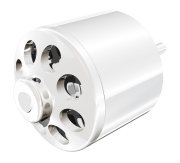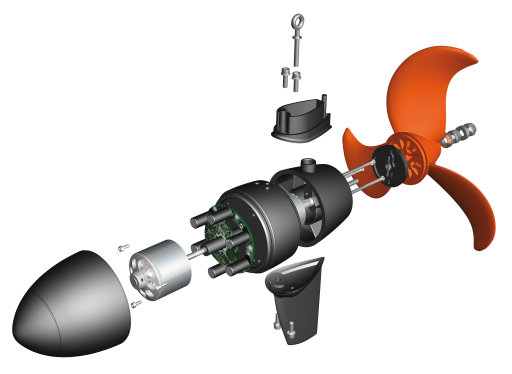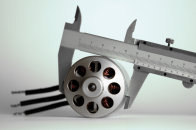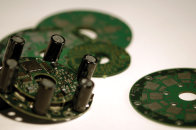|
Strong core: Torqeedo torque motors
The motor is the core of a
boat drive. With its torque motors, Torqeedo sets new standards in the areas
of torque, efficiency and power per weight and volume. The motor which
equips the Travel 801 with the effective power of a 2 HP combustion engine
only weighs 500 g and is no larger than a packet of cigarettes.
In the case of a torque motor, the objective of the design is to use as many
factors as possible to maximize the torque. Torqeedo has uncompromisingly
optimized the torque motor and, with the introduction of synchronous motors,
which come as permanent excited magnet, electronically commutated and
designed as external rotor motors, has created true torque giants.
However, that is not all: The use of high-tech materials further improves
the performance parameters of the Torqeedo torque motors: a Torqeedo motor,
such as that used in the Travel 801 model, uses rare earth magnets instead
of hexaferrites.
Altogether, it exceeds a conventional internal rotor motor by 24-fold torque
– although it is the same size. Combined with a 1:14 step-down gear, the
800-watt motor can easily drive a propeller typically used by a 20 HP
combustion engine.
The Torqeedo motors also take on a new dimension with regard to efficiency.
They experience no excitation current and brush losses: and are equipped
with additional, patented control mechanisms, reducing losses to a minimum.
The efficiency not only ensures the efficient use of the available battery
capacity – it also prevents thermal problems. In this way, Torqeedo can
combine high performance with a small structural shape.

Cliquez pour agrandir
Clever brain – the new
digital Torqeedo power electronics
The electronic commutation of
electric motors described above can generally be either analog or digital.
While most providers of electric motors continue to work mechanically using
carbon brushes for commutation, Torqeedo has gone two steps further and uses
digital power electronics in its new motor models. In contrast to analog-based
electronic commutation, digital electronics has a more intelligent power
control and handling.
This provides more power, more stability and more comfort.
The intelligence of the power control is in its combination of propeller-speed
control and control of the power intake. The propeller-speed control
regulates the rpm of the propeller, i.e. the motor keeps tightly within the
speed specifications and draws whatever power it requires to reach the
defined propeller-speed.
If, on the other hand, the power consumption is controlled then the drive
processes the power made available to it as good as it can and the resultant
force is then the speed of the propeller. What is the concrete significance
of intelligently combining these types of control logic? For example, the
Torqeedo electronics functions speed-controlled within low power ranges in
order to allow slow maneuvering that is absolutely precise to within a
centimeter. In other cases, the electronics controls the motor via the power
intake: e.g. to provide a very light boat with a higher final speed or to
provide the driver with a defined power level to maximize the range.
Additionally, intelligent control logics allows the motor control to adapt
itself to the use of alternative propellers, e.g. when optimizing speed or
thrust by using alternative propellers.
legal mentions - Copyright
Jean-Pierre Masquelier
|




